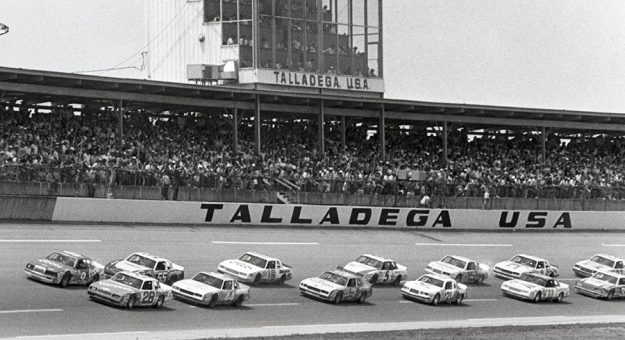R.J. Reynolds
Then, in late 1970, a major turn of events sent the sport in an entirely new direction. What was yet another departure by the auto manufacturers presented an opportunity that saved the sport from what many believed could have been dire.
Junior Johnson, the winner of 50 Cup Series races as a driver from 1953 through 1966, turned his attention to team management alongside team owner Richard Howard during the late 1960s.
The Wilkes County, N.C., native approached R.J. Reynolds Tobacco Co. executives about sponsoring Howard’s single-car team in the fall of 1970. The Winston Salem, N.C.-based corporation had a much bigger plan in mind.
“I started talking to the people at Winston and it wasn’t long at all before they were asking questions about what else they could do in the sport and how they could take a bigger role,” Johnson said in the April 1992 edition of American Racing Classics. “I told them they really needed to talk with the people at Daytona (NASCAR officials) and before too long went by, Winston had become the series sponsor and we were chasing the Winston Cup championship.”
Johnson’s conversation led to the longest running series sponsorship in motorsport’s history from 1971 through 2003 with an estimated $300 million being paid to drivers, teams and tracks over 33 years while bringing stock car racing into the mainstream.
“In the years before R.J. Reynolds became the series sponsor, all of the awards dinners were very informal. So much so that at times, some of the top-10 finishers in points wouldn’t be there,” said longtime motorsports writer Tom Higgins before his death in July 2018. “RJR coming into NASCAR was the best thing that ever happened. You couldn’t go by a country store without seeing some type of Winston banner pertaining to them promoting the next race on the schedule. RJR was everywhere and I credit them for bringing NASCAR from a southeastern regional sport to a national sport. They gave NASCAR national credibility.”
With changes in tobacco advertising laws, the relationship between NASCAR and RJR ended in 2003.
Nextel and Sprint continued NASCAR Cup Series sponsorships through 2016 before Monster Energy came on board from 2017 through 2019. The series sponsorship is currently shared by Busch, Coca-Cola, GEICO and Xfinity under the Cup Series moniker.
Johnson become a six-time Cup Series championship team owner with drivers Cale Yarborough and Darrell Waltrip and was inducted into the NASCAR Hall of Fame in the inaugural class in 2010.
Television
Television executives have taken an interest in auto racing since 1960, beginning with glimpses of the Daytona 500 and other major superspeedway events on a tape-delayed basis.
On April 10, 1971, ABC Sports broadcast live flag-to-flag coverage of a 200-lap race from Greenville-Pickens Speedway in Greenville, S.C., won by Bobby Isaac by two laps. It was a rather lackluster race, as France asked all the competitors to be on their best behavior for the national audience.
Television decision-makers were reluctant to do it again until the 1979 Daytona 500. It was a much more exciting race that ended with a fight among Bobby Allison, Donnie Allison and Cale Yarborough after Donnie Allison and Yarborough crashed on the final lap while racing for the win. Richard Petty won his sixth of seven Daytona 500s with Darrell Waltrip and A.J. Foyt in hot pursuit.
“That race wasn’t supposed to be all that popular but 42 years later, we’re still talking about it because of what happened after the race,” said Donnie Allison. “That race introduced millions of people to NASCAR that may not have ever known anything about it had there not been a major snowstorm that trapped everyone in their homes. We didn’t set out for it to end that way with us getting it a scuffle at the end. That just happened. NASCAR should still be paying us for doing that.”
Over the past four decades, the television deals negotiated with CBS, ABC, ESPN, TNN and TBS have risen from an estimated $3 million in 1985 to an incredible $8.2 billon with the FOX and NBC networks through 2024.
New Cars
In 1981, NASCAR moved from 115-inch wheel-base cars to 110-inch wheel-base machines. Cars were further developed and raced throughout the 1980s and the early 1990s.
“I remember when we went to the smaller wheelbase like we have now in 1981, they (NASCAR) just announced, ‘OK, we’re gonna downsize the cars. The wheelbase is gonna be shorter. It’s going to 110 inches,’” said Eddie Wood, co-owner of Wood Brothers Racing. “Everybody thought, ‘Wow, that’s gonna be the end of the world.’ Everybody showed up at Daytona. They had a race and it was great. Things work out in racing.
“At the end of the day, they still had a race, somebody won it (Petty, his seventh 500) and everybody went on. Like I said, usually their decisions, even if they’re really big, they work out.”
The Car of Tomorrow debuted in 2006 following a five-year design period that began after Dale Earnhardt’s death in 2001.
